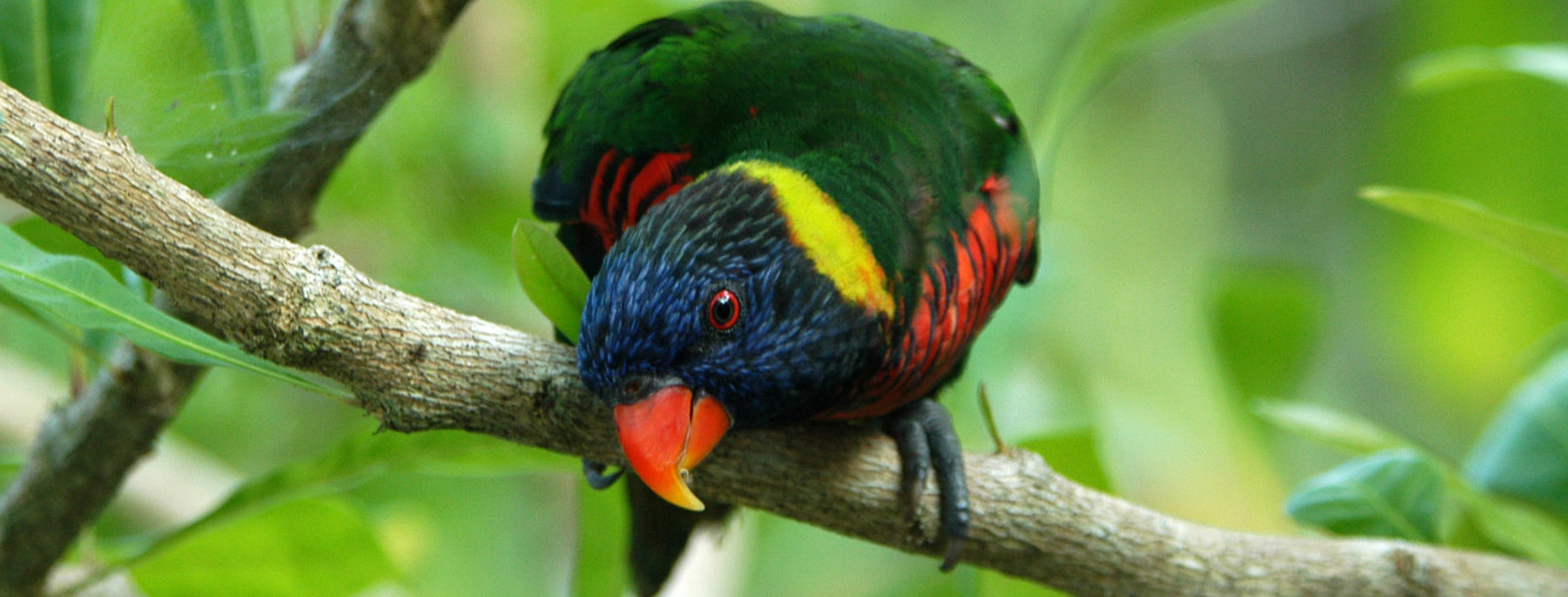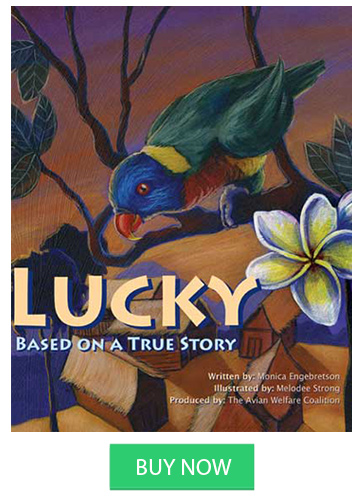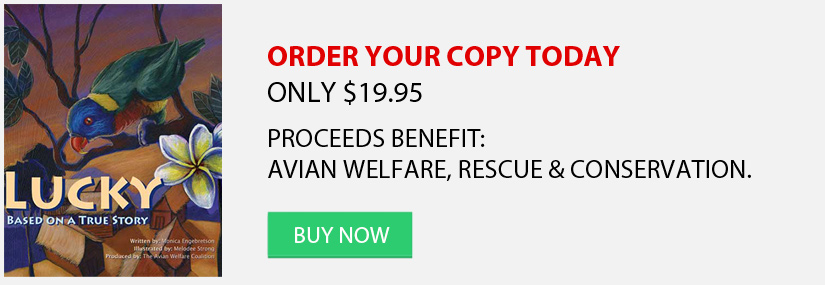Lucky the Lorikeet
About the Book
This children’s book - based on a true story - tells the story of Lucky, a parrot who is captured in the wild and eventually regains his freedom with the help of a young boy.
Inspired by real events that book place in Indonesia, this much-awaited story is beautifully illustrated in a 32-page softcover book. What’s more, proceeds from the sale of this book benefit avian welfare, rescue, and conservation – to help birds like Lucky.
The story is also a perfect fit for a wider educational curriculum including geography and culture of Indonesia, the natural history, behavior, and physical characteristics of parrots and tropical forest ecosystems, as well as real-life conservation efforts. .
Lucky is a publication of the Avian Welfare Coalition, and was produced with assistance and support from the World Animal Protection, American Society for the Prevention of Cruelty to Animals, Animal Welfare Trust, Born Free USA and Midwest Avian Adoption and Rescue Services.
About the Author
Monica Engebretson has worked professionally in the animal protection movement for over 20 years. Her work has included, field work, undercover investigations, lobbying, and media and public education campaigns. Monica also holds a degree in wildlife science with an emphasis on environmental ethics from Humboldt State University. She has traveled twice to Indonesia for parrot conservation projects. She is currently the North American Program Manager for Cruelty Free International and a Board Member of the Avian Welfare Coalition.
Endorsements
“Lucky,” Monica Engebretson’s beautiful, moving book is a story that children will adore. Lucky is a not-so-lucky Lorikeet captures for the pet trade and sold as a gift to a little boy. But the boy’s compassion, kindness, and perseverance bring back the bird’s luck, and teach us all how what real love is – wanting what is best for others. I loved this book, and you and your children will, too. “
-Zoe Weil, President of Institute for Humane Education.
“Wild parrots are no different than other wild birds. They love freedom. They are not meant to live in captivity. Unfortunately, many people have troubled grasping this fact. Monica Engebretson’s wonderful story, Lucky, should go a long way toward changing this misperception among young people. She clearly knows wild parrots. I can see and feel their familiar, magical ways throughout her story. Highly recommended.
-Mark Bittner, author of The Wild Parrots of Telegraph Hill
“Often a story about an individual animal can make a difference in the lives of the humans who read it and the animals with whom they interact. Lucky is one such tale, about a bird – a beautiful rainbow lorikeet – named Lucky who was captured, taken care of by a young boy named Kersen, and they released because Kersen came to realize that keeping Lucky as a pet and depriving him of his freedom was wrong. As Lucky flew away with a flock of other lorikeets, Kersen shouted, “I love you Lucky and I understand.” Kersen continued taking care of other unfortunately captive birds until they could fly to freedom. Lucky presents a inspirational win-win situation for all the beings involved, human and nonhuman. Thanks to Monica Engebretson for sharing this story with us.
-Marc Beckoff, Professor Emeritus of Ecology and Evolutionary Biology, University of Colorado and Author
Meet the real "Lucky" who inspired our children’s book in this narrated video. Shot on the island of Seram, Indonesia.
From the Author of “Lucky”
I first met Lucky while traveling in the “Spice Islands” with the Indonesian Parrots Project, a U.S. non-profit parrot conservation group, and Yayasan Wallacea, an Indonesian non-governmental organization focused on sustainable community development.
Lucky was trapped in the wild and had been chained to a perch (a common practice in Indonesia) for more than a year. Lucky had been fed a diet of consisting primarily of rice and sweet tea – a lorikeets natural diet consists of nectar and fruit.
Lucky’s “owner” had acquired him as a gift and was not in the business of trapping or selling birds. We acquired Lucky with the intent to release him on the island of Seram, near the villages of Sawai and Masihulan where parrot conservation projects are active.
We soon discovered that because Lucky had been chained for so long his flight muscles had weakened. Without the ability to fly he would not survive in the wild. We could not bear the thought of allowing Lucky to spend the rest of his life chained to a perch as a “pet,” so we decided to free Lucky from the chain with the hope that he would remain in the protection of the village until he was strong enough to leave.
Lucky did remain around the village, climbing and chewing on trees and regaining his flying ability. A month later, Lucky left the village for the forest.
Lucky, and other birds like him, were the inspiration for the creation of a rehabilitation and released center aptly named ‘kembali bebas” – Indonesian for “return to freedom” – which has since been established on the island of Seram where Lucky was released.
For more information about Indonesian Parrot Project and how you can help, visit http://indonesian-parrot-project.org/
Learn with Lucky: Class Activities and Lessons
You can incorporate the story of Lucky into a complete lesson plan encompassing biology, geography, and arts and culture. Below are some fun activities and class lesson ideas.
Role-playing exercise: instruct children to imagine and imitate that they are a parrot flying freely with their friends and family – their flock. Next, ask children to image and play out being captured and chained (to their desks/chairs). Finally, instruction children to imagine and imitate that they’ve been freed and slowly learn to fly again – like Lucky did.
Eat like a Lorikeet: As described in Lucky – lorikeets lap up nectar with their tongues that look like tiny toothbrushes. Kids will enjoy trying to “eat like a lorikeet.” Give students small cups of juice (“nectar”) and instruct them to attempt to use their tongue to lap up nectar like a lorikeet.
Have a “Lorikeet Lunch:” Serve a variety of fruit and juice (“Nectar” if possible eat outdoors or under the trees. During the lunch encourage children to communicate by chirping and squawking and gesturing – no talking
Nature Films: Nature documentaries can play an important role in science education by showing animals interacting in their natural environment and by presenting the unique humane wildlife interface and conservation challenges that exists where the animals live. Check out these resources:
National Geographic’s Resource Library for Educators
https://www.nationalgeographic.org/education/resource-library/
https://video.nationalgeographic.com/video/animals/birds
PBS Videos https://www.pbs.org/wnet/nature/group/birds/
https://www.pbs.org/wnet/nature/episodes/
Indonesian Parrot Project Conservation
https://wildlifemessengers.org/ipp/
http://indonesian-parrot-project.org/
Your class can also watch a video clip of the real Lucky here!
https://youtu.be/vt6sMQsgiu0
Geography: Geography is a subject frequently overlooked in American schools. Use the story of Lucky to teach children about the history and geography of the Indonesian islands: https://en.wikipedia.org/wiki/Indonesia
Art and Culture: One of the best ways to make learning fun is through art. Art is also a great way to instill cultural appreciation and awareness. For information on the arts and crafts of Indonesia visit:
http://www.expat.or.id/info/artshandicrafts-indonesia.html
Language: Learning new languages are fun! Teach students a few common Indonesian words and phrases:
Ya. Yes
Tidak. No.
Silikan. Please.
Terima kasih. Thank you.
Terima kasih kemdali. You’re welcome
Maafkan saya. I am sorry
Selamat pagi. Good Morning
Selamat tinggal. Good-bye.
Selamat tidur. Good night.
For more common phrases visit: https://en.wikibooks.org/wiki/Indonesian/Important_Phrases




